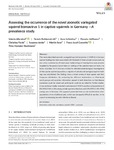Assessing the occurrence of the novel zoonotic variegated squirrel bornavirus 1 in captive squirrels in Germany —A prevalence study
Allendorf, Valerie
Rubbenstroth, Dennis
Schlottau, Kore
Hoffmann, Donata
Frank, Christina
Amler, Susanne
Beer, Martin
Conraths, Franz Josef
Homeier‐Bachmann, Timo
The newly described zoonotic variegated squirrel bornavirus 1 (VSBV‐1) in German squirrel holdings has been associated with the death of three private owners and one zoo animal caretaker (confirmed cases). Epidemiological investigations were severely impeded by the general lack of data on holdings of the putative reservoir hosts, the family Sciuridae. To fill this lack of data for detailed epidemiological investigations of the captive squirrel population, a register of private and zoological squirrel holdings was established. The findings show a broad variety of kept species and their frequency distribution. By contacting the different stakeholders via Web‐based social groups and societies, information passed in both directions so that disease awareness could be raised and participants could be recruited for further studies. Cross‐sectional studies revealed a prevalence of VSBV‐1‐positive subpopulations of 0% (95% CI 0%–6.2%) among private squirrel collections and 1.9% (95% CI: 0%–9.9%) among zoos in Germany. The approach presented here can be transferred to other populations of non‐traditional pets, which may be equally difficult to monitor, in the case of an emerging zoonotic infectious disease.
Dateien zu dieser Publikation

